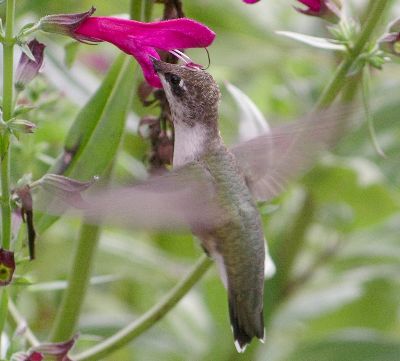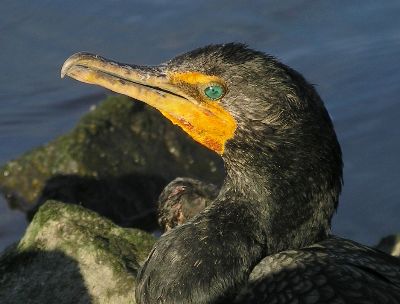
A hummingbird claims my flower subject as its own
As one might predict, close encounters with birds do not occur nearly as frequently as sightings made on a walk through the woods, driving down the highway, or watching migrating flocks far overhead. Often, they occur when least expected. I've been amazed at the poor observational powers of white-winged doves as they land by our pond to drink. This can happen when I am within arm's reach of them. I might be weeding the garden or cleaning out plants in the pond, and suddenly, with a sweep of feathers, a dove lands nearby. At such times, I am usually so startled that I jerk away, and the motion then brings me to the attention of the bird and it flies away. But there was the brief moment when we made eye contact and I could see every feature and feather of its dumbfounded face. Maybe it thought the same of me.
 A hummingbird claims my flower subject as its own |
Perhaps the most frequent avian visitors to a garden are hummingbirds. Who has not been inspected by one of these little sprites, and instinctively ducked to avoid what sounds like a huge wasp or bee? Sometimes, the flower I'm photographing is the same one that a hummingbird wants too. Some of the funniest episodes I've watched in our backyard involve a pair of males: one a ruby-throated hummingbird and the other a neon skimmer. The latter is a brilliant red dragonfly that lives in and around our pond. When I am near the pond, the dominant male neon skimmer will always check me out, hovering nearby, perhaps hoping I will go away so he can get back to the job of watching for females. There are also flowers near the pond, which are of no interest to the skimmer, but certainly get the attention of hummingbirds. Sometimes, and I presume it is the red color of both that sets them off, male hummingbirds and dragonflies will chase each other around, even flying all the way around the house in only seconds and ending up back by the pond. Sometimes the bird chases the dragonfly and sometimes it is the other way around. Each is protecting a valuable resource, even if they don't happen to agree on what it is.
When I was about 6 or 7 years old, we had a large bird feeder in our backyard garden. It was up on a pole, well over my head, and was shaped like a triangle. Two sides were glassed in, while the open end had a flat fin-like projection; the whole contraption swiveled with the wind, just like a weather vane, keeping the open side leeward. One summer, a robin laid her eggs in a perfectly constructed nest right in the middle of this protected haven. With the help of my parents, I could get a lift up to see, first the eggs, and then later the nestlings. I took great delight in using tweezers to put earthworms into their gaping mouths. After we'd fed the brood, the parent would then appear and try to get them to eat even more. However, they were already stuffed and it was funny to see the adult almost scratching her head in confusion over babies that didn't want to eat.
Most chances to actually hold a wild bird occur when the bird is injured. Sometimes it ends well, such as once when a brilliant red cardinal flew into our glass door. We put the lovely creature into a box to see if it would recover. When we opened it up a short time later, it flew off as quick as any healthy bird might. Other times, there is no hope for the bird. Once, when riding my bike home from college, I found a blue jay in the road that had been hit by a car. It was flopping around but its neck was obviously broken. It was heartbreaking to have to put it out of its misery, but I also couldn't stand to leave it there to suffer.
A favorite vacation destination for our family was Cape Hatteras National Seashore. Our main activity there was always beach walking, and one time a storm had left several loons high and dry near the dunes. These are large birds, with feet so far back on their bodies that they have trouble moving about on land. My sister and I noticed that they couldn't seem to make it down the beach to the water. So, intrepid teenagers that we were, we went ahead, grabbed the beak to keep from being stabbed, lifted each struggling bird (careful to point the rear end away from us) and carried them down to the water. Once in the waves, they pushed off and swam away in no time.
 A cormorant tangled in fishing line awaits its fate |
Birds that learn to beg for food from humans, or even just get acclimated to their close presence, are usually easy to approach if not downright aggressive. I've been attacked by swans and geese that obviously feel that I'm withholding food when I don't even have any. Not to mention those that are protecting nests that I might kayak too close to. Herons and cranes in Florida routinely grab bait and catch alike from fishermen, and gulls can be so excited by the possibility of a free meal that it can feel like a scene from du Maurier's story, "The Birds."
I can only vaguely remember the myriad times I've seen flocks of birds overhead, from cloudlike swarms of blackbirds to thousands of cranes in an aerial highway far up in the sky, but the memories that remain in clear detail are those that happen to be close. Going home from high school, I once suddenly heard a loud whooshing sound and looked up to see a flock of Canada geese, flying just over the tops of the single story houses between which I was walking. On a recent trip to Wisconsin, we saw four trumpeter swans fly low over the field where we were planting trees. While walking the dog early in the morning, I've been buzzed by hawks, surprised by the silent flight of a very close owl, and totally alarmed as a turkey flung itself across the path, making so much noise that it sounded like a whole bevy of birds. Some birds just weren't meant to fly.
One of the cutest encounters was with a tiny burrowing owl. This was quite some time ago, and occurred at the edge of a parking lot on my morning dog walk. The little owl swept up from the side and landed on a boulder just 10 feet from me, and less from the dog's surprised face. It stood there for a while, staring us down, looking exactly like the birds in television documentaries that I'd seen. It cocked its head back and forth. And it didn't back down. We did. I pulled the dog away and we continued on our trek. I wasn't about to argue over territory with a feisty little owl!
Whether its the sudden discovery of a nest full of babies, a brief but memorable chance meeting, or an opportunity to help a bird out of a tricky predicament, there's nothing that beats the thrill of up-close birding.